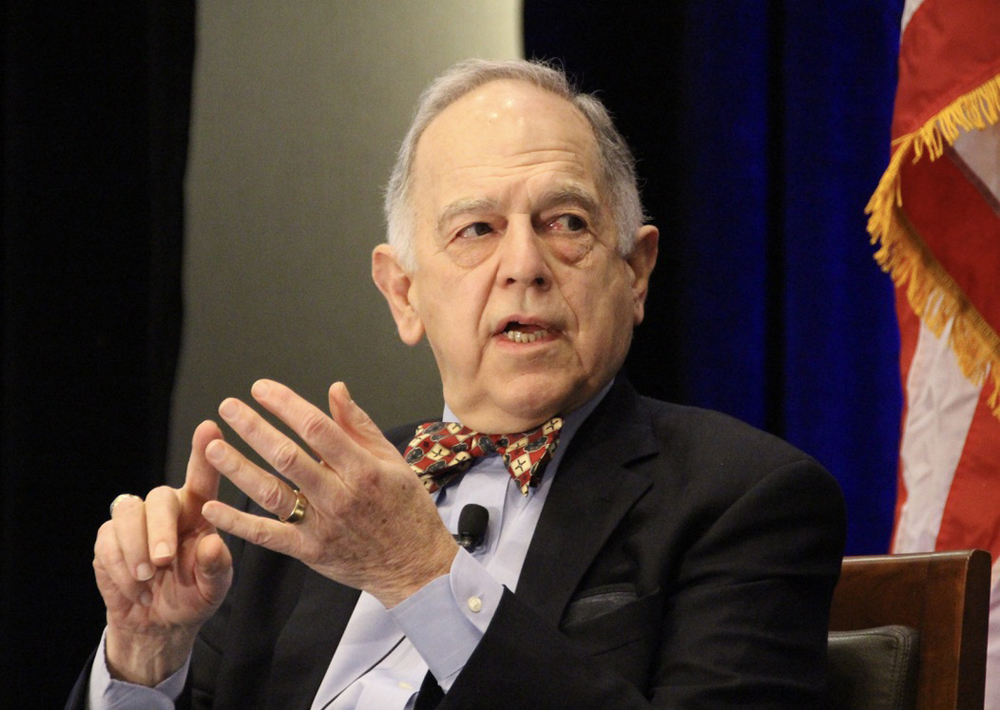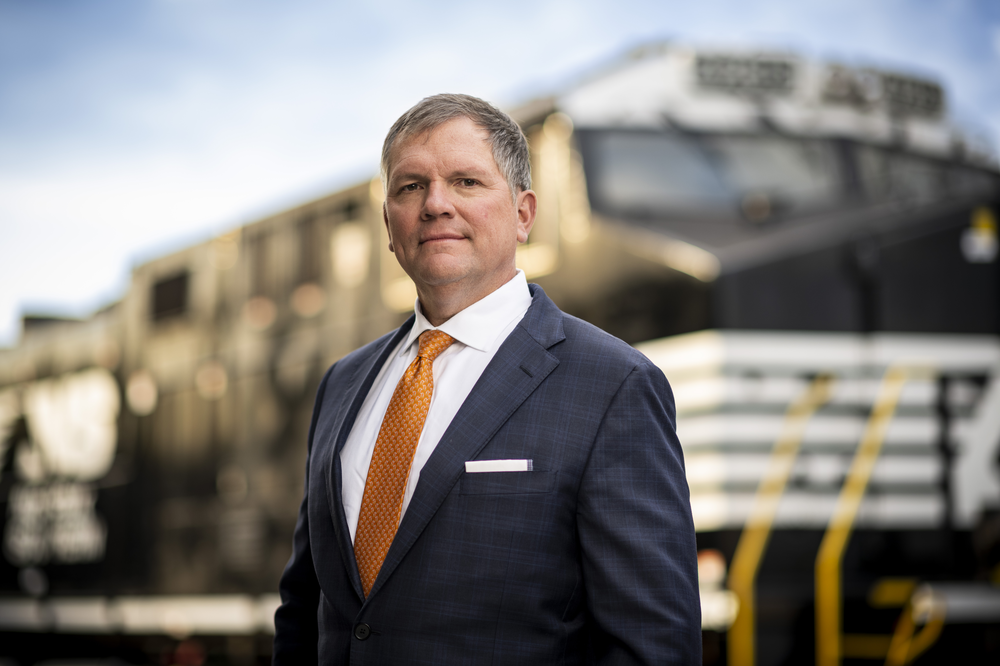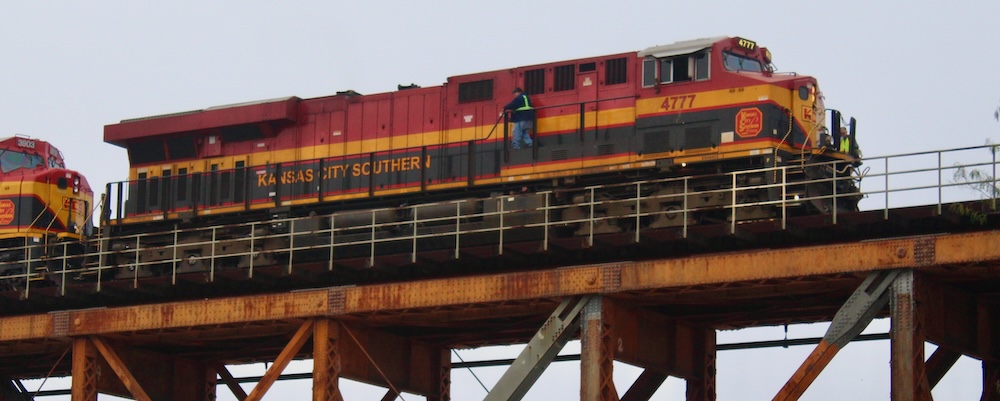
WASHINGTON — Surface Transportation Board Chairman Martin J. Oberman says he’s concerned about reports that an activist investor plans to launch a proxy fight to oust Norfolk Southern CEO Alan Shaw.
“Is this an investor whose goal it is to reinstate the bad old days when the marching orders to the C-suite were to cut, cut, cut? That would be bad,” Oberman said in an interview with Trains today. “We’re just trying to rebuild the system and it’s been a long, slow process to get there.”
Cleveland-based Ancora Holdings has amassed a $1 billion stake in Norfolk Southern and aims to wrest control of the company’s board and replace Shaw, according to a report in the Wall Street Journal. Ancora has met with NS to express its displeasure with the way the railroad handled its response to the East Palestine, Ohio, hazardous materials derailment last year as well as missing its financial targets.

Shaw in December 2022 unveiled a long-term growth strategy that relies on not furloughing train crews during downturns so that the railroad can handle volume upswings and maintain service levels. Although the strategy would hurt the railroad’s operating ratio in the short term, it would pay off in the long run by allowing the railroad to capture more freight and generate higher revenue and profits, Shaw has said.
Oberman has praised Shaw’s long-term plan, as well as the similar growth strategies being followed at CSX, Canadian National, and BNSF Railway. He also has been critical of what he says is the negative influence that Wall Street’s short-term focus has on the railroad industry.
Amid disappointing quarterly results and the mounting financial toll of East Palestine, there has been speculation for months that activist investors were putting a target on Shaw’s back, Oberman noted. “It is a matter of serious concern,” he says. “And if they succeed, how is this going to affect the understandable human reaction of the other CEOs the next day?”
A successful bid to reverse Shaw’s strategy at NS would dim the industry’s growth prospects and hurt shippers, the economy, and the environment, Oberman says. “It would be very shortsighted,” he says. “I’ve been around long enough to be very concerned about what these investors’ motivations are, but it’s hard to make a judgment at this point without knowing all the facts.”
Ancora has not responded to Trains’ requests for comment.
If Ancora aims to bring in a chief executive who would focus on cost-cutting and the operating ratio at the expense of service, Oberman says it likely would prompt a regulatory response from the STB and legislative action in Congress.
Oberman noted that retiring BNSF Executive Chairman Matt Rose in 2019 warned that the other Class I railroads were inviting regulatory risk by adopting Precision Scheduled Railroading, reducing service, and demarketing some types of traffic in pursuit of higher profits.
What would Oberman say to Wall Street and Norfolk Southern investors?
“I would channel Matt Rose,” Oberman says, referring to the former BNSF CEO and chairman. “If you keep this up eventually the Congress will move and it certainly will motivate the STB to use more of our regulatory authority to go even further. We have things under way now that the railroads are not crazy about, like the proposed reciprocal switching rule.”
The STB also could consider other ways to grant sole-served shippers competitive access to a second railroad, Oberman says. Railroads have long opposed what they call “forced access,” saying it would cause operational problems, serve as a disincentive to investment, and hurt profits.
“We cannot afford to let up for the benefit of the country, the economy, and the environment,” Oberman says. “We cannot afford to look the other way.”
Oberman lamented the short-term focus of analysts on the NS fourth quarter earnings call, who peppered Shaw with questions about improving the operating ratio and boosting profit margins. Shaw defended the railroad’s strategy, saying it was in the best long-term interest of Norfolk Southern shareholders.
“Not one analyst said, ‘How long is it going to take you to grow your revenue with your long-term plans, and what will that mean to the profits for shareholders two years from now or three years from now?’ The question never came up,” Oberman says.
If the activist investors have the same short-term focus, it would be “a serious concern,” Oberman says.
On Jan. 25 — the day before NS announced fourth quarter results — Shaw told employees that the railroad was cutting 7% of its executive and staff workforce through a voluntary severance program. The move, which would affect about 300 positions, was necessary to bring costs in line with revenue, Shaw said.
Oberman says he understands the investor pressure that Shaw is facing, but said management cutbacks would hurt the railroad’s ability to grow.
The STB’s service hearings in 2022 focused on a shortage of train and engine crews, which had caused widespread service problems on the big four U.S. railroads. Railroads have largely restored their crew employment levels.
“But to run a robust railroad and serve customers and grow traffic, you need the white-collar forces,” Oberman says. “You need sales reps. You need customer reps. We don’t hear it as much from shippers who are having problems when they say they can’t get a train. But we do hear frequently that we can’t get a salesperson on the phone.”
Regulators this week extended their requirement that the big four U.S. railroads continue to provide the board with detailed monthly employment data. Oberman says the board’s service hearings and data reporting requirements were an incentive for railroads to hire conductors after the wave of furloughs at the onset of the pandemic left them short of train crews in 2022.
“There’s plenty of room for the STB to shine sunshine on these tactics … and put some public pressure on them to move in the other direction,” Oberman says.
Norfolk Southern is the only one of the big four U.S. railroads that did not furlough train crews in the past couple of years, Oberman said, citing STB data.
“NS should not be punished for not furloughing people,” Oberman says. ”That was the whole idea for keeping the staff there. Traffic’s coming back and you’re going to need it.”














There’s a good article about Ancora this morning on CNBC.com
Damn, I hate to see Oberman leave. His insight as to what railroads should be is really good. And, he was and is not bashful about telling it like it is.
It is unfortunate that Mr. Oberman is leaving, I don’t always agree with him, but I agree he cares and is dedicated to his job. I trust his leadership of the STB and his departure will be a loss.
The simplest solution would be to set a minimum OR that the railroads have to meet, and that is something the STB can do right now under it’s current authority. Setting it at 65 might not solve all the problems, but that’s a lot higher than the 55 some railroads want to get to. By minimum OR I mean the OR can not go below that amount, it can go above, but not below.
The STB’s “current authority ” is unconstitutional (as well as every other administrative authority) other than enforcement under the executive branch. Only Congress has the authority to set policy under Article I section I of the Constitution.
Thanks to retiring Baby Boomers and their 401K’s, the only “long-term” investors are those still working. With the demise of company-funded pensions, new retirees depend on the proceeds of their 401K’s for month-to-month income. Thus, the rise of “activist” investors trying to keep food on the table and a roof overhead for a growing population of retirees. Socialist Insecurity was never intended to be a sole income source. And as I said, the demise of company-funded pensions have led to what is essentially a “Wall Street Casino” mentality for retirees merely trying to survive. Does it make for good corporate decision making? No. But, that’s not the reason why people invest. People invest in order to live. Not merely to make money.
Wrong, wrong and wrong…first off, you still need that long term growth in your 401K if you plan on drawing out of it monthly. Secondly Social Security could be funded adequately if instead of a flat ceiling for withholding taxes it scaled with your salary, there’s no reason a person making $100k a year should pay the same amount of Social Security tax as someone making $10M or $40K a year. Third, a 401K is supposed to provide you enough to retire on, that’s why they have “catch-up” provisions and it was set up to replace private pension funds. The only thing you got right was that Social Security was ORIGINALLY not intended to be a sole source of income, but it was changed to become that and that has been it’s purpose for at least 6 decades now.
Mr. McFarlane, you make some good points. However I did address the need for long-term growth for those still working, Your suggestion about adequate funding of Social Security does not address the immediacy of what’s facing current retirees. That’s the group the activists prey upon. Their mantra is “the future is now”. The “catch-up” provisions are useless when the politicians see perpetual inflation as the means for a “government giveaway” to their indentured voters.
As for railroads, the Class 1’s are seriously undervalued in the marketplace right now. There is room for at least one more Class 1 merger. While CPKC was a “Border-to-Border” merger, I see the next one as being not just “Border-to-Border”, but the “Coast-To-Coast” merger the old ICC was always ready to deny. The question would be, “who would buy who” And, for “how much”? The obvious partners are BNSF, UP, CSX, and NS. The question would be who is going to make the best deal? Not long ago, the activist Children’s Investment Fund of the UK made a run at CSX. It makes sense (from their perspective) to make a run at another U.S. Class 1 railroad. Remember, that these are investors. Not railroaders. They have no interest in the products or services provided by the businesses they invest in.
Like I said yesterday, I have never ever seen a company acquired by a hedge fund, activist group succeed. At best if they do survive, they are a shell of what they were as all the money gets sucked out of the company. Now I understand why companies do buy backs, for survival.
I’m voting my shares with Shaw. And if he’s out, I’m out. Long term is the only way.
I worked or a high tech IT company. An activist investor group gained control. Surprise we were bought by a rival and everyone was fired. The “activists” walked away with a major bonus.
Good for UP, buy back your stock.
Any wonder why UP and other railroads are buying back stock? It is to keep these activist piranhas at bay and limit their influence. The only reason all these Investors got their foot hold in railroad financials and operations was all the stupid IPO’s that the railroads thought would boost their profits. Instead it was like a Sword of Damocles inches from their heads, allowing all these short-term profiteers to use their leverage to ruin the industry. Remember, Precision Scheduled Railroading was not about cutting cost, but to use precision methods to schedule trains and improve on time delivery to increase customer satisfaction. But with accounting in charge at the Class Ones, it tuned in to turning a deaf ear on customers and trying to encourage outside investment or in other words, a reliance on Wall Street. Can we agree that this was a BAD MOVE? Whole heartedly. No legitimate company or corporation benefits when investors are only interested in taking short term profits against long term gains. As Warren Buffett, “The Oracle of Omaha,” has said over and over, Long term gains are the only ones worth having. He said in one instance, “They may not make you rich, but they will keep you rich…” And since it is the Wall Street Analysts telling these investment portfolios what to do, smart decisions go out the window and like mnded people (accountants) give up their freedom to the greed mongers!
They know you are exiting Marty, they know they can move in now.